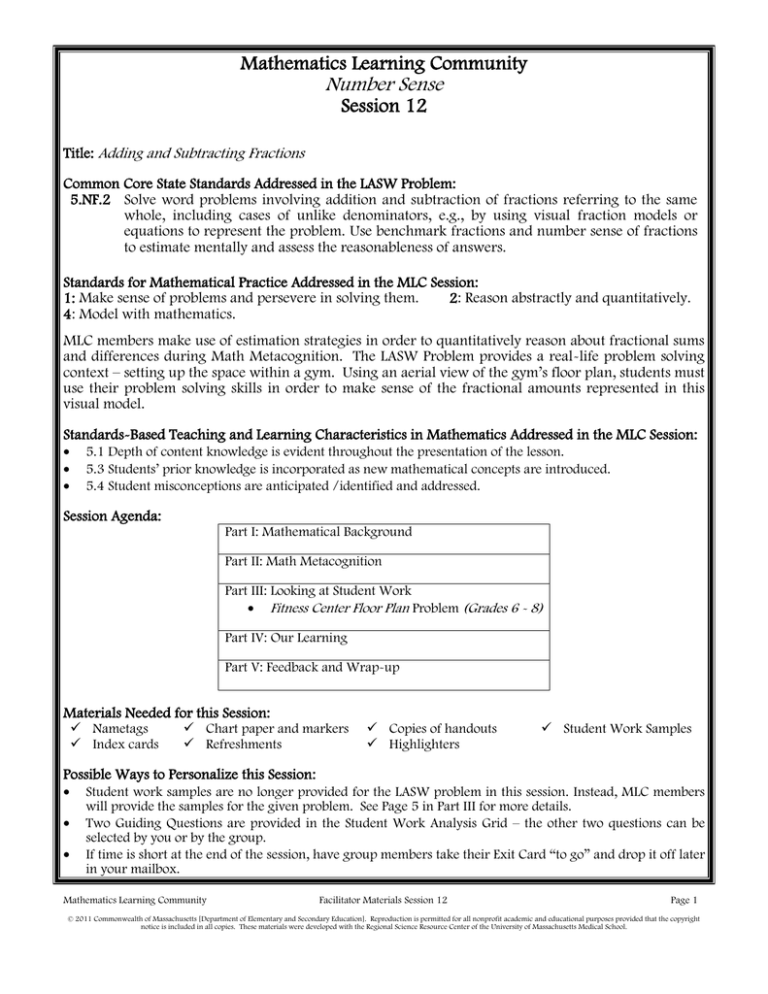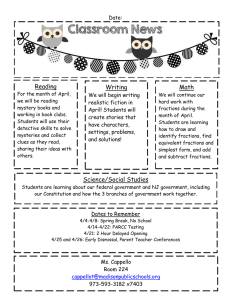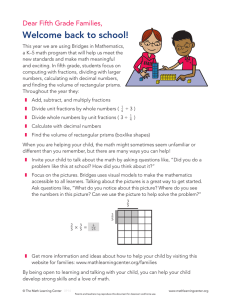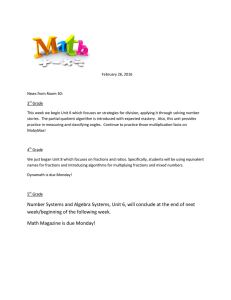MLC12
advertisement

Mathematics Learning Community Number Sense Session 12 Title: Adding and Subtracting Fractions Common Core State Standards Addressed in the LASW Problem: 5.NF.2 Solve word problems involving addition and subtraction of fractions referring to the same whole, including cases of unlike denominators, e.g., by using visual fraction models or equations to represent the problem. Use benchmark fractions and number sense of fractions to estimate mentally and assess the reasonableness of answers. Standards for Mathematical Practice Addressed in the MLC Session: 1: Make sense of problems and persevere in solving them. 2: Reason abstractly and quantitatively. 4: Model with mathematics. MLC members make use of estimation strategies in order to quantitatively reason about fractional sums and differences during Math Metacognition. The LASW Problem provides a real-life problem solving context – setting up the space within a gym. Using an aerial view of the gym’s floor plan, students must use their problem solving skills in order to make sense of the fractional amounts represented in this visual model. Standards-Based Teaching and Learning Characteristics in Mathematics Addressed in the MLC Session: 5.1 Depth of content knowledge is evident throughout the presentation of the lesson. 5.3 Students’ prior knowledge is incorporated as new mathematical concepts are introduced. 5.4 Student misconceptions are anticipated /identified and addressed. Session Agenda: Part I: Mathematical Background Part II: Math Metacognition Part III: Looking at Student Work Fitness Center Floor Plan Problem (Grades 6 - 8) Part IV: Our Learning Part V: Feedback and Wrap-up Materials Needed for this Session: Nametags Index cards Chart paper and markers Refreshments Copies of handouts Highlighters Student Work Samples Possible Ways to Personalize this Session: Student work samples are no longer provided for the LASW problem in this session. Instead, MLC members will provide the samples for the given problem. See Page 5 in Part III for more details. Two Guiding Questions are provided in the Student Work Analysis Grid – the other two questions can be selected by you or by the group. If time is short at the end of the session, have group members take their Exit Card “to go” and drop it off later in your mailbox. Mathematics Learning Community Facilitator Materials Session 12 Page 1 © 2011 Commonwealth of Massachusetts [Department of Elementary and Secondary Education]. Reproduction is permitted for all nonprofit academic and educational purposes provided that the copyright notice is included in all copies. These materials were developed with the Regional Science Resource Center of the University of Massachusetts Medical School. Part I: Mathematical Background Approximate Time: 20 Minutes Grouping: Whole Group A. Welcome members of your group to the Math Learning Community. Remind group of established norms. B. Today’s Content: a. The mathematics during this session focuses on naming fractional parts of a whole, and then adding and subtracting these fractions. b. What do we need to know in order to be able to add and subtract fractions? c. Chart ideas to refer to during the Protocol for LASW. d. Two of the most important underlying ideas of fractions should be discussed at this time. Without understanding these ideas, performing operations will be done only procedurally, rather than based on fraction-sense and understanding: i. Relative nature of fractions: Fractions, by definition, express a relative relationship. Even when estimating, one must understand and keep track of what the fractional relationship to the whole is. In addition, keeping track of what unit is being used is equally important. ii. Equivalency: The concept of equivalency is used to add and subtract fractions. The ability to represent fractional quantities in equivalent forms using common denominators serves as the basis for the traditional algorithm for fraction addition and subtraction. C. Relating Content to the Three C’s Theme: a. How do the ways in which children learn to add and subtract fractions relate to the ways in which they add and subtract whole numbers? How are these processes different? b. Do children compose and decompose fractions in ways that makes it easier for them to operate, as can be done with whole numbers? If so, how? If not, why not? Mathematics Learning Community Facilitator Materials Session 12 Page 2 © 2011 Commonwealth of Massachusetts [Department of Elementary and Secondary Education]. Reproduction is permitted for all nonprofit academic and educational purposes provided that the copyright notice is included in all copies. These materials were developed with the Regional Science Resource Center of the University of Massachusetts Medical School. Part II: Math Metacognition Approximate Time: 25 minutes Grouping: Whole Group A. Problem: The problem used for this session is appropriate for Grades 6 – 8. Ask group members to solve these problems in more than one way. Most people will gravitate towards the use of common denominators, so it’s important to have them consider other methods. Examine the following pairs of problems. Keep track of your thinking as you determine which sum or difference is greater. 8 3 or 4 6 7 4 5 11 1 1 or 4 3 3 4 15 11 3 6 4 5 or 4 7 5 6 B. Solution to Problem: 1st set: 8 3 7 4 2nd set: 4 3 3 4 3rd set: 4 5 5 6 C. Problem Intent: (Note: The problem intent for all Math Metacognition problems is the same). See Session 2 for more information. In addition, this problem serves as a good start to discussing methods used to add and subtract with fractions. Also, some of the quantities used in this problem are close enough that estimation skills will get one only so far. See below for two common estimation strategies involving fractions. In this way, more specific addition and subtraction strategies can be shared and discussed. Using Benchmark Fractions Strategy: Round the fraction to the nearest benchmark: 0, ¼, ½, ¾, 1 Example: 3 6 4 7 Estimate: ¾ + 1 = 1 ¾ 4 5 5 6 Estimate: ¾ + 1 = 1 ¾ Conclusion using this estimation strategy: both sums are equivalent Converting to a Decimal Strategy: Use the relationship between numerator and denominator to round the fraction to a decimal. Example: 3 6 Estimate: .75 + .9 = 1.65 4 7 4 5 5 6 Estimate: .8 + .85 = 1.65 Conclusion using this estimation strategy: both sums are equivalent D. Discuss the following: a. How did each group member think of determining the sum or difference for each set? What addition and subtraction strategies are reasonable to use with these problems? Can they be replicated with other problems? Have your group chart these out. b. Ask group members to describe how their strategies changed given the different problem sets, if at all. c. Following from that, however, consider the efficiency and effectiveness of all strategies used. For example, is a visual model or a number line model a reasonable tool to use with these problems? Why or why not? Mathematics Learning Community Facilitator Materials Session 12 Page 3 © 2011 Commonwealth of Massachusetts [Department of Elementary and Secondary Education]. Reproduction is permitted for all nonprofit academic and educational purposes provided that the copyright notice is included in all copies. These materials were developed with the Regional Science Resource Center of the University of Massachusetts Medical School. Part III: Looking at Student Work (LASW) Approximate Time: 50 minutes Grouping: Refer to protocol A. Complete the MLC protocol with the group. B. Problem: The problem used for this session is appropriate for Grades 5 – 8. A new fitness center is going to be built soon in your city. The floor plan for the center is shown below: Show your work or explain your thinking for each of the following: 1. 2. 3. Label each section with its fraction of the total area of the fitness center. The owners of the fitness center have now decided to use 1/8 of the Pool’s area to install showers. What fraction of the total area of the fitness center will the Pool now cover? Explain your thinking. The Weights, Aerobics, and Treadmills sections will be renamed as one section called the Workout Zone. What fraction of the total area of the fitness center will the Workout Zone now cover? C. Solution: a. Question 1: Weights: 5 64 8 1; 64 8 ; Aerobics: 12 3 ; Spa: 8 1; 64 8 64 and Pool 16 Lockers: 4 1 ; 64 16 1 64 ; Treadmills: 7 64 ; Bikes: Lobby: 3 ; Basketball Court: 64 16 1 . 64 4 b. Question 2: Pool Area – 1 8 of Pool Area = New Pool Area. 1 7 16 8 1 . 1 1 1 . 8 16 1 16 . * * ?. 64 32 4 8 4 32 32 32 32 64 8 64 c. Question 3: Weights: 8 1; 64 8 Treadmills: 7 64 ; Aerobics: 12 3 . 64 16 Workout Zone = 8 7 12 27 . 64 64 64 64 D. Problem Intent: This problem combines different fractional concepts into a realistic problem-based context. Students first have to work to name the sections (fractional parts) of the fitness center (whole) using a given unit. Refer back to Session 11’s discussion abut what decisions are involved in the process of defining the unit. In this problem, the most commonly used unit is 1 , however students might use 1 , which is the size of the smallest 32 64 section, the Lockers. In addition, fractions must be combined as sections are grouped together and fractions must be subtracted as areas are removed. E. Discuss the strategies used to solve this problem. Pay particular attention to different strategies used to name fractional sections, as well as different methods for combining or comparing fractional amounts. Mathematics Learning Community Facilitator Materials Session 12 Page 4 © 2011 Commonwealth of Massachusetts [Department of Elementary and Secondary Education]. Reproduction is permitted for all nonprofit academic and educational purposes provided that the copyright notice is included in all copies. These materials were developed with the Regional Science Resource Center of the University of Massachusetts Medical School. Part III: Looking at Student Work (LASW), continued F. Misconceptions/Questions that May Arise: a. M: If using this problem with Grade 6 or higher, watch for students who continue to name a particular area of the fitness center with a “list” of fractional quantities (i.e., ½ + ¾), rather than providing one quantity to name the combined sections (1 ¼). Consider this to be a red flag for students who do not understand fractional quantities and who may not see how a mixed number can represent one quantity. b. M: Keeping track of the unit is a common challenge with a problem such as this. c. Q: How does the kind of visual thinking required for this problem tie directly back to the development and use of the area model? By helping students to recall prior knowledge of the area model for multiplication, teachers can help students to make sense of fractions and fractional operations by connecting back to what they knew and understood with whole number operations. Options for Customization G. Guiding Questions: Two Guiding Questions have been provided in the Student Work Analysis Grid for this problem. As a way to customize the LASW process, you (or your group) will need to decide on the remaining two questions. You can use the two questions listed below that are specific to this problem or refer to the list of generic questions found on Page 5 in Session 7. a. How does the student combine and compare fractional quantities? b. How does the student make use of visual models, including the floor plan, when solving the problem? H. Using A Group Member’s Student Work: a. Prior to offering this session to your MLC, you need to collect student work samples for the task: Fitness Center Floor Plan. b. See Page 5 in Session 7 for more details on collecting student work samples. For this task, select 4 samples to discuss during the MLC session. Prior to photocopying samples, mark them as A, B, C, and D. Mathematics Learning Community Facilitator Materials Session 12 Page 5 © 2011 Commonwealth of Massachusetts [Department of Elementary and Secondary Education]. Reproduction is permitted for all nonprofit academic and educational purposes provided that the copyright notice is included in all copies. These materials were developed with the Regional Science Resource Center of the University of Massachusetts Medical School. Part IV: Our Learning Approximate Time: 20 Minutes Grouping: Whole Group A. Discussion: After evidence of student understanding has been discussed as a whole group, you want to facilitate discussion around how the LASW process will impact what teachers do within their classrooms. Some questions to help guide discussion include: a. What do we take away after LASW? b. What did we learn? About student thinking? About our own knowledge? 1. Refer back to chart made at the beginning of the session c. How does today’s session relate to important mathematical content and pedagogy? d. How does it impact your practice at your grade level? (Note: In order to help teachers connect this session to the mathematics within their own grade level, refer to the information below). Making Connections Across the Grade Levels K – 2: Naming parts of a whole begins at this grade band through the development of the concepts of whole, half and other common fractions. In addition, the notion of comparing, adding, and subtracting whole number quantities develops, laying the foundation for work with fractions. (K.CC.6, K.OA.2, 1.OA.1, 1.G.2, 1.G.3, 2.OA.1, 2.G.3) 3 – 5: The development of the concept of equivalency begins in this grade band, as students further develop an understanding of fractions. In addition, students in this grade band actively work to use various models to compare fractions and to add and subtract positive fractions. The LASW problem is appropriate for Grade 5 (as well as middle grades) to explore and specifically addresses learning standard 5.NF.2. (3.NF.1, 3.NF.3 a – d, 3.MD.5 a – b, 3.MD.6, 3.MD.7 a – d, 3.G.2, 4.NF.1, 4.NF.2, 4.NF.3 a – d, 5.NF.1, 5.NF.3) 6 – 8: Fractional computation continues to be an area of weakness for most middle school students. This work is so important to address as it will directly translate to a student’s success in Algebra I and beyond. (6.RP.3 a – d, 6.NS.7, 7.RP.2 a – d, 7.NS.1 a – d, 7.NS.3, 7.EE.3) B. Writing a Problem or Task: As a way to synthesize learning from today’s session, ask MLC members to come up with a math problem or task that would embody the ideas discussed today. The problem should be appropriate to use at their grade level. Writing these problems will help both you as the facilitator and the other group members to develop a stronger sense of how these mathematical ideas show up in classrooms from grades K – 8. (Note: See Part IV in Session 1 for more details). Mathematics Learning Community Facilitator Materials Session 12 Page 6 © 2011 Commonwealth of Massachusetts [Department of Elementary and Secondary Education]. Reproduction is permitted for all nonprofit academic and educational purposes provided that the copyright notice is included in all copies. These materials were developed with the Regional Science Resource Center of the University of Massachusetts Medical School. Part V: Feedback & Wrap-up Approximate Time: 5 Minutes Grouping: Individual A. Closing: Close the session with a message such as: “Hope you leave here with more questions – about student thinking, about your teaching, and ways that we as a group can help support one another.” Have group members keep in mind the following: Dialogue, Reflection, and Inquiry are the keys to successful learning. B. Exit Cards: Pass out exit cards for group members and ask them to provide some feedback to you as the facilitator. Select one or two questions from the list below to help them summarize their thinking about the mathematics from today’s session. Collect exit cards so that a summary can be shared during the next session. Feedback / Exit Card Questions How does the mathematics that we explored connect to your own teaching? How do I see what we’ve done today relate to key mathematical ideas or pedagogical content knowledge? What idea or discussion topic did you find most interesting from today’s session. Why? How was this session for you as a learner? What ideas were highlighted for you in today’s session that you had not previously considered? What are you taking away from today’s session? Mathematics Learning Community Facilitator Materials Session 12 Page 7 © 2011 Commonwealth of Massachusetts [Department of Elementary and Secondary Education]. Reproduction is permitted for all nonprofit academic and educational purposes provided that the copyright notice is included in all copies. These materials were developed with the Regional Science Resource Center of the University of Massachusetts Medical School. Math Metacognition Examine the following pairs of problems. Keep track of your thinking as you determine which sum or difference is greater. 8 3 7 4 Mathematics Learning Community or 4 6 5 11 1 1 15 11 or 4 3 3 4 3 6 4 7 or 4 5 5 6 Facilitator Materials Session 12 Page 8 © 2011 Commonwealth of Massachusetts [Department of Elementary and Secondary Education]. Reproduction is permitted for all nonprofit academic and educational purposes provided that the copyright notice is included in all copies. These materials were developed with the Regional Science Resource Center of the University of Massachusetts Medical School. LASW Problem A new fitness center is going to be built soon in your city. The floor plan for the center is shown below: 1. Label each section with its fraction of the total area of the fitness center. 1 of the Pool’s area to install 8 showers. What fraction of the total area of the fitness center will the Pool now cover? Explain your thinking. 2. The owners of the fitness center have now decided to use 3. The Weights, Aerobics, and Treadmills sections will be renamed as one section called the Workout Zone. What fraction of the total area of the fitness center will the Workout Zone now cover? Mathematics Learning Community Facilitator Materials Session 12 Page 9 © 2011 Commonwealth of Massachusetts [Department of Elementary and Secondary Education]. Reproduction is permitted for all nonprofit academic and educational purposes provided that the copyright notice is included in all copies. These materials were developed with the Regional Science Resource Center of the University of Massachusetts Medical School. Student Work Analysis for: Fitness Center Floor Plan Student What strategy is used to name the sections of the fitness center? How is the student’s understanding of equivalency evident in the work? A B C D Mathematics Learning Community Facilitator Materials Session 12 Page 10 © 2011 Commonwealth of Massachusetts [Department of Elementary and Secondary Education]. Reproduction is permitted for all nonprofit academic and educational purposes provided that the copyright notice is included in all copies. These materials were developed with the Regional Science Resource Center of the University of Massachusetts Medical School.


